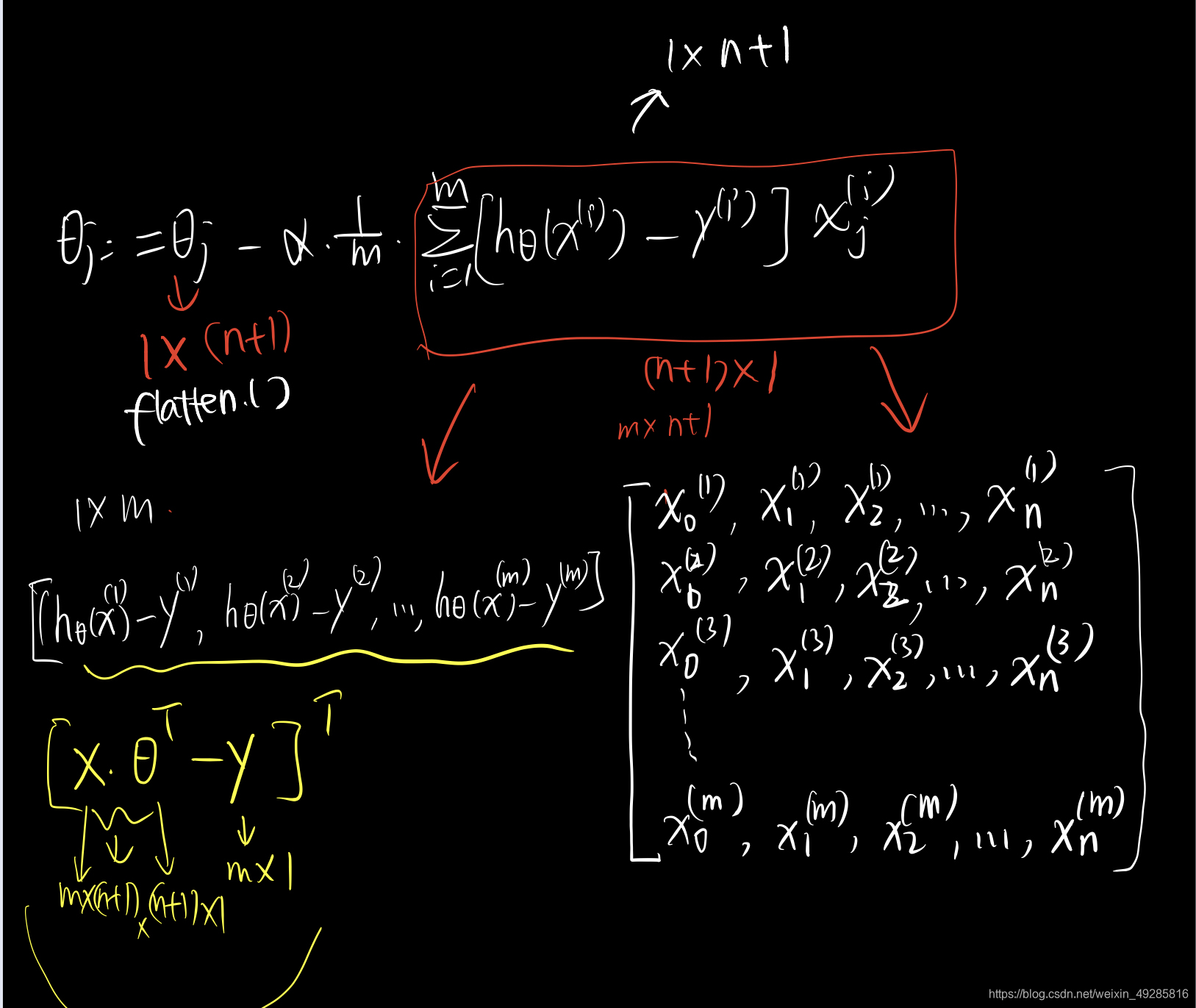目录:
import pandas as pd
import numpy as np
import matplotlib.pyplot as plt
一、单变量线性回归
1、计算代价函数cost function
data=pd.read_csv('/Users/appleguanliyuan/Desktop/yokin_data_analyst_learning_materials/Matalab/machine-learning-ex/ex1/ex1data1.txt',header=None,names=['population','profit'])
data.head()
| population | profit | |
|---|---|---|
| 0 | 6.1101 | 17.5920 |
| 1 | 5.5277 | 9.1302 |
| 2 | 8.5186 | 13.6620 |
| 3 | 7.0032 | 11.8540 |
| 4 | 5.8598 | 6.8233 |
def computeCost(X, y, theta): #注意,这里传入的theta和X,y都应该为matrix形式,以为矩阵想乘直接用*即可,数组则需要.dot()
inner = np.power(((X * theta.T) - y), 2)
return np.sum(inner) / (2 * len(X))
((X * theta.T).T - y)*X 的形式为:

data.insert(0, 'Ones', 1) #插入一列 1
data.head()
| Ones | population | profit | |
|---|---|---|---|
| 0 | 1 | 6.1101 | 17.5920 |
| 1 | 1 | 5.5277 | 9.1302 |
| 2 | 1 | 8.5186 | 13.6620 |
| 3 | 1 | 7.0032 | 11.8540 |
| 4 | 1 | 5.8598 | 6.8233 |
# set X (training data) and y (target variable)
cols = data.shape[1] # 列数
X = data.iloc[:,0:cols-1] # 取前cols-1列,即输入向量
y = data.iloc[:,cols-1:cols] # 取最后一列,即目标向量
#转换为矩阵形式
X = np.matrix(X.values)
y = np.matrix(y.values)
theta = np.matrix([0,0])
X.shape, theta.shape, y.shape
# ((97, 2), (1, 2), (97, 1))
((97, 2), (1, 2), (97, 1))
theta为0时的代价函数
computeCost(X, y, theta) # 32.072733877455676
32.072733877455676
2、梯度下降函数 gradient descent function
def gradientDescent(X,y,theta,alpha,iterations):#需要传入学习几率,梯度下降次数,参数值,X的值和因变量的值
#都要确保传入的是矩阵!
#暂存theta,为满足后续同时更新需要
theta_temp=np.matrix(np.zeros(theta.shape)) #初始化赋值为0的theta矩阵
#参数theta的个数
theta_num=int(theta.flatten().shape[1]) #flatten函数是把数组或矩阵降为一维,横着降为一维后,shape[1]表示取列数,即个数
cost=np.zeros(iterations) #初始化一个ndarray,包含每次循环的cost
m=X.shape[0] #样本数量m
for i in range(iterations):#i从0开始,结束值为iterations-1
#利用向量化求解
theta_temp=theta-(alpha/m)*(X*theta.T-y).T*X #注意,为1*n+1的向量
theta=theta_temp
cost[i]=computeCost(X,y,theta)
return theta,cost
#已知:
alpha=0.01
iterations=1500
#则:
final_theta,cost=gradientDescent(X,y,theta,alpha,iterations)
final_theta
matrix([[-3.63029144, 1.16636235]])
computeCost(X,y,final_theta)
4.483388256587726
3、可视化代价函数
plt.title("Visualizing J(θ)")
plt.xlabel("iterations")
plt.ylabel("cost")
plt.plot(np.arange(iterations), cost, color="red")
# np.arrange(iterations)为迭代轮数,cost为每轮的损失值,这个计算要插入到梯度下降过程中,计算和记录。
[<matplotlib.lines.Line2D at 0x7fddc8329250>]

二、多变量线性回归
data2=pd.read_csv('/Users/appleguanliyuan/Desktop/yokin_data_analyst_learning_materials/Matalab/machine-learning-ex/ex1/ex1data2.txt',header=None,names=['Size','Bedrooms','Price'])
data2.head()
| Size | Bedrooms | Price | |
|---|---|---|---|
| 0 | 2104 | 3 | 399900 |
| 1 | 1600 | 3 | 329900 |
| 2 | 2400 | 3 | 369000 |
| 3 | 1416 | 2 | 232000 |
| 4 | 3000 | 4 | 539900 |
1、特征归一化
data2[['Size','Bedrooms']]=(data2[['Size','Bedrooms']]-data2[['Size','Bedrooms']].mean())/data2[['Size','Bedrooms']].std()
data2.head() #'注意,price因变量不用归一化'
| Size | Bedrooms | Price | |
|---|---|---|---|
| 0 | 0.130010 | -0.223675 | 399900 |
| 1 | -0.504190 | -0.223675 | 329900 |
| 2 | 0.502476 | -0.223675 | 369000 |
| 3 | -0.735723 | -1.537767 | 232000 |
| 4 | 1.257476 | 1.090417 | 539900 |
2、多元回归
# add ones column
data2.insert(0,'Ones',1)
#set X(training data) and y(target variable)
cols=data2.shape[1]
X2=data2.iloc[:,0:cols-1]
y2=data2.iloc[:,cols-1:cols]
#convert to matrices and initialize theta
X2=np.matrix(X2.values)
y2=np.matrix(y2.values)
theta2=np.matrix([0,0,0])
#perform linear regression on the data set
theta_of_multiple_regression,cost2=gradientDescent(X2,y2,theta2,alpha,iterations)
#get the cost of the model
computeCost(X2,y2,theta_of_multiple_regression)
#iterations=1500, alpha=0.01的时候的Cost
2043283576.6373606
plt.title("Visualizing J(θ)")
plt.xlabel("iterations")
plt.ylabel("cost2")
plt.plot(np.arange(iterations), cost2, color="red")
#np.arrange(iterations)为迭代轮数,cost为每轮的损失值,这个计算要插入到梯度下降过程中,计算和记录。
[<matplotlib.lines.Line2D at 0x7fddc8518ac0>]

3、改变iterations和alpha的值时
#当iterations=100, alpha=0.01时,
iterations=100
alpha=0.01
theta3,cost3=gradientDescent(X2,y2,theta2,alpha,iterations)
theta3
matrix([[215810.61679138, 61384.03125186, 20273.55045338]])
#改变iterations后,先调用梯度下降函数计算出theta的值,然后带入computeCost'函数
computeCost(X2,y2,theta3)
10621009943.600248
plt.title("Visualizing J(θ),iterations=100,alpha=0.01")
plt.xlabel("iterations")
plt.ylabel("cost3")
plt.plot(np.arange(iterations), cost3, color="red")
#下图可以看出可以增加alpha的值
[<matplotlib.lines.Line2D at 0x7fddc8579ee0>]

三、 正规方程Normal equation求解
def normalEqn(X,y):
theta=np.linalg.inv(X.T*X)*X.T*y
return theta
#theta的值此时,算出来时 (n+1)*1维度
final_theta2=normalEqn(X,y)
final_theta3=final_theta2.flatten() #转化为1*n+1,因为computeCost方程会再次转置为(n+1)*1
final_theta3
matrix([[-3.89578088, 1.19303364]])
computeCost(X, y, final_theta3)
4.476971375975179
参考:https://blog.csdn.net/Cowry5/article/details/80174130
修改:对原文正则方程中取消了点乘,增加了不同iterations和alpha的可视化,增加了矩阵相乘的可视化





















 923
923











 被折叠的 条评论
为什么被折叠?
被折叠的 条评论
为什么被折叠?








